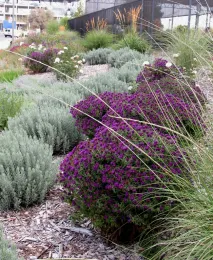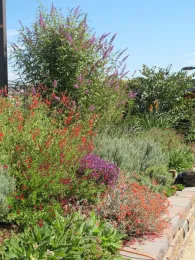
And then, one day cities began reading those water meters and charging the nice, water loving citizens by the units of water used each month. You could almost tell the day the bills arrived. Neighbors discussed them at the mailbox with anger, frustration, even fear. “How can I afford this every month?” Or “How can I reduce my monthly bill?” And that was the birth (or at least the beginning) of serious discussions about how to be “water wise” or how to conserve water to lower the units of water consumption that consequently will lower the monthly bill.

During this last drought, many people just stopped watering their lawn. This helped reduce their water bill but does little else. In many cases it killed street trees as well.
Not watering grass in our climate guarantees that the grass will die. In its place, however will be weeds. Weeds can live and multiply in harsh, waterless conditions. And all those weeds are spreading seeds that land in your neighbor's lawns. And eventually even the weeds die from normal life cycle or lack of water. Then the wind blows the precious topsoil from your yard. This topsoil mixes with the other air in our valley and adds to air pollution.
What if I want to keep my lawn?
There are a few things you can do if you do not want to give up your lawn completely. Think about reducing the amount of lawn in your yard, which can help you save water and money. Having a beautiful yard without green grass does not mean just rocks, cactus, or artificial turf. Begin by removing a small section of the grass. Check with the Stanislaus Master Gardeners and local nurseries for plant suggestions to replace that green grass with other green, or gray, or yellow plants. Think beyond bark, boulders, and bare ground. The possibilities are endless. This time of the year is a perfect time to begin making plans for that winter yard renovation!

What are some easy tips to save water?
Now, if you are not ready to commit to a grassless or partially grassless yard there are some changes that can help in reducing water consumption. First, examine your current watering system. If you have a sprinkler system, do not assume that it is working properly. Checking weekly during the warm weather is a must, especially after the lawn is mowed and in the daylight. Is everything working properly, sprinklers putting water on the lawn not the sidewalk or street? Are the sprinklers clogged, broken, or even missing? If you have an automatic timer, check the timer, and remember to decrease time and days as the daylight time shortens and weather cools, and turn the sprinklers off when the rains begin. Be an agent of change for the better! Making a few changes now can make a difference in your water bill, landscape, and our world because we are all in it together.
-----
Join Rho Yare on Zoom for an evening of tips on how to reduce your water bill, yard work, pesticide use, all while having a gorgeous yard on Tuesday, October 27, 2020 from 6:00-7:30 p.m. Sign up at http://ucanr.edu/sustainable/2020 to receive your link.

